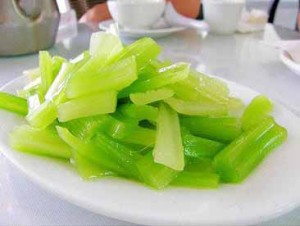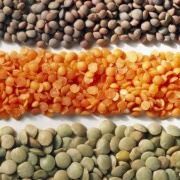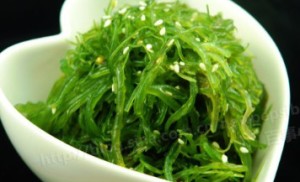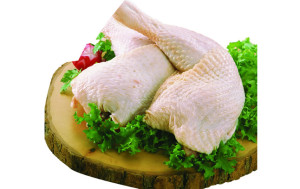Now people pay more and more attention to food diet, so what kind of food is healthy? Which are not so good for ours body?In this story, we will introduce the following five kinds of healthy food to you:
By:Yi wang 134302149 class2
Eat This, Not That! This story has rounded up five of the most underappreciated and undereaten foods that can instantly improve your diet. Make a place for them on your plate, and you’ll gain a whole new respect for the health benefits they bestow—from lowering blood pressure to fighting belly fat. And the best part? You’ll discover just how delicious health food can be.
- Celery
 Per large stalk:
Per large stalk:
* 10 calories
* 0 g fat (0 g saturated)
* 51 mg sodium
* 1 g fiber
This water-loaded vegetable has a rep for being all crunch and no nutrition. But ditch that mindset: Celery contains stealth nutrients that heal.
Why it’s healthy
“My patients who eat four sticks of celery a day have seen modest reductions in their blood pressure—about 6 points systolic and 3 points diastolic,” says Mark Houston, M.D., director of the Hypertension Institute at St. Thomas Hospital, in Nashville. It’s possible that phytochemicals in celery called phthalides are responsible for this health boon, since these compounds relax muscle tissue in artery walls and increase bloodflow, according to nutritionist Jonny Bowden, Ph.D., author of The 150 Healthiest Foods on Earth. And beyond the benefits to your BP, celery also fills you up with almost no calories.
- Seaweed
Per Tbsp, dried:
* 20 calories
* 1 g fat (0 g saturated)
* 73 mg sodium
* 4 g protein
While this algae is a popular health food in Japan, it rarely makes it into U.S. homes.
Why it’s healthy
There are four classes of seaweeds—green, brown, red, and blue-green—and they’re all packed with healthful nutrients. “Seaweeds are a great plant source of calcium,” says nutritionist Alan Aragon, M.S. They’re also loaded with potassium, which is essential for maintaining healthy blood pressure levels. “Low potassium and high sodium intake can cause high blood pressure,” Bowden says. “Most people know to limit sodium, but another way to combat the problem is to take in more potassium.” (Here’s a cool hint: You can buy sheets of dried seaweed at Asian groceries, specialty health stores, or online at edenfoods.com. Use a coffee grinder to grind the sheets into a powder. Then use the powder as a healthy salt substitute that’s great for seasoning salads and soups—certainly beats the heart-harmful salt in any of these 20 saltiest foods in America.)
- Scallops
 Per 1 ounce, steamed:
Per 1 ounce, steamed:
* 31 calories
* 0 g fat (0 g saturated)
* 74 mg sodium
* 6 g protein
* 111 mg Omega-3 fatty acids
Perhaps these mollusks are considered guilty by association, since they often appear in decadent restaurant meals that are overloaded with calories. (But then again, so does asparagus. )
Why they’re healthy
Scallops are more than 80 percent protein. “One 3-ounce serving provides 20 grams of protein and just 95 calories,” says Bowden. They’re also a good source of both magnesium and potassium. (Clams and oysters provide similar benefits.) Try them: It’s a fast, easy way to prepare them.
- Lentils
Per cup:
 * 230 calories
* 230 calories
* 1 g fat (0 g saturated)
* 16 g fiber
* 18 g protein
It’s probably no surprise that these hearty legumes are good for you. But when was the last time you ate any?
Why they’re healthy
Boiled lentils have about 16 grams of belly-filling fiber in every cup. Cooked lentils also contain 27 percent more folate per cup than cooked spinach does. And if you eat colored lentils— black, orange, red—there are compounds in the seed hulls that contain disease-fighting antioxidants, says Raymond Glahn, Ph.D., a research physiologist with Cornell University. Use them as a bed for chicken, fish, or beef—they make a great substitute for rice or pasta.
Per chicken drumstick:
* 112 calories
* 6 g fat (2 g saturated)
* 14 g protein
Sure, dark meat has more fat than white meat does, but have you ever considered what the actual difference is? Once you do, Thanksgiving won’t be the only time you “call the drumstick.”
Why it’s healthy
“The extra fat in dark turkey or chicken meat raises your levels of cholecystokinin (CCK), a hormone that makes you feel fuller, longer,” says Aragon. The benefit: You’ll be less likely to overeat in the hours that follow your meal. What about your cholesterol? Only a third of the fat in a turkey drumstick is the saturated kind, according to the USDA food database. (The other two-thirds are hearthealthy unsaturated fats.) What’s more, 86 percent of that saturated fat either has no impact on cholesterol, or raises HDL (good) cholesterol more than LDL (bad) cholesterol— a result that actually lowers heart-disease risk. (The kind of fat you should really be afraid of is trans-fatty acids. Avoid any items on our list of the trans-fattiest foods in America). As for calories, an ounce of dark turkey meat has just 8 more calories than an ounce of white meat.






It‘s interesting~ I hope they not only heathy but also delicious